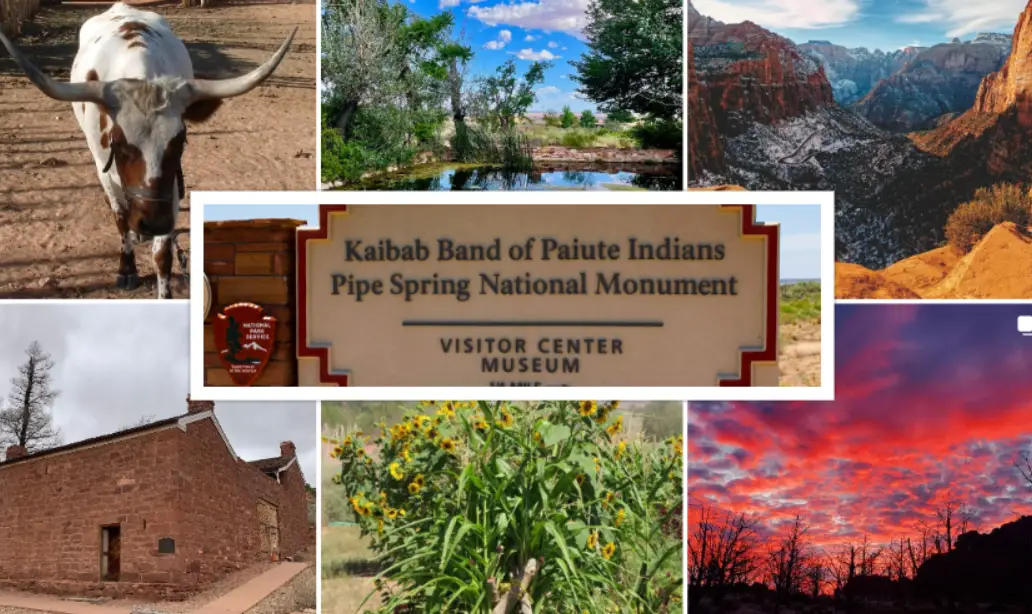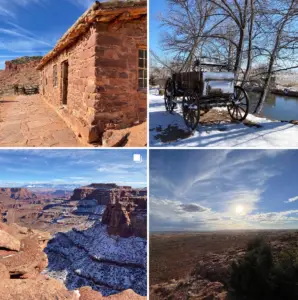Pipe Spring National Monument : Interesting Facts, History & Travel Guide

- By
- Aparna Patel
- |
- 13 Apr, 2023
- |

Pipe Spring National Monument is a stunning destination located in northern Arizona that is rich in history and natural beauty. The monument sits atop a spring that has been a vital water source for both Native American tribes and early Mormon settlers.
Today, visitors can explore the park’s historic structures, including a fort and a museum, and take in breathtaking views of the surrounding desert landscape.
In this blog post, we’ll delve into the fascinating history and geology of Pipe Spring National Monument, provide interesting facts about the site, and offer a comprehensive travel guide to help you plan your visit to this incredible destination. So, let’s discover the wonders of Pipe Spring National Monument together!
Table of Contents
Interesting facts about Pipe Spring National Monument
- Pipe Spring National Monument is located in the state of Arizona in the United States.
- The monument was established by President Calvin Coolidge on May 31, 1923, to preserve the history and culture of the Kaibab Paiute and Mormon pioneers who settled in the area.
- The monument encompasses an area of 40 acres and is situated at an elevation of 4,900 feet.
- The main attraction of Pipe Spring National Monument is the historic fort and ranch complex that was built by Mormon pioneers in the 1870s. The complex served as a waystation for travelers and provided a safe haven for settlers during the Indian Wars.
- The natural spring that gives the monument its name was used by the Kaibab Paiute people for thousands of years before the arrival of European settlers. The spring was also used by Mormon pioneers and served as an important source of water for the region.
- The monument is home to a variety of plant and animal species, including desert tortoises, coyotes, and rattlesnakes.
- Visitors to Pipe Spring National Monument can take a guided tour of the fort and ranch complex, explore the natural spring, and learn about the history and culture of the Kaibab Paiute people and the Mormon pioneers.
- The monument is open year-round, although hours of operation may vary depending on the season.
- Pipe Spring National Monument is located near several other popular tourist destinations, including Zion National Park and the North Rim of the Grand Canyon.
Read More:
- Petroglyph National Monument : Interesting Facts, History & Travel Guide
- Organ Pipe Cactus National Monument : Interesting Facts, History & Travel Guide
- Organ Mountains–Desert Peaks : Interesting Facts, History & Travel Guide
- Oregon Caves National Monument : Interesting Facts, History & Travel Guide
- Newberry Volcanic Monument : Interesting Facts, History & Travel Guide
- Muir Woods National Monument : Interesting Facts, History & Travel Guide
Information & History of Pipe Spring National Monument
Pipe Spring National Monument is a United States National Monument located in the state of Arizona. It is a 40-acre property that preserves the history and culture of the Kaibab Paiute and Mormon pioneers who settled in the area. The monument is located near the Arizona-Utah state line, in the Arizona Strip region. The main attraction of the monument is the historic fort and ranch complex that was built by Mormon pioneers in the 1870s.
The natural spring that gives the monument its name was used by the Kaibab Paiute people for thousands of years before the arrival of European settlers. The spring was also used by Mormon pioneers and served as an important source of water for the region. The water from the spring flows through a pipeline into the fort and is used for irrigation and other purposes.
The fort was built by Mormon settlers who were sent by Brigham Young to establish a waystation for travelers and provide a safe haven for settlers during the Indian Wars. The fort was constructed using local materials, such as volcanic rock and adobe. It was used as a headquarters for the Church of Jesus Christ of Latter-day Saints’ cattle ranching operations in the area.
The fort and ranch complex served as a waystation for travelers and provided a safe haven for settlers during the Indian Wars. The Kaibab Paiute people were also allowed to use the spring and surrounding land for their traditional practices, and they continue to have a strong connection to the area.
In 1923, President Calvin Coolidge established Pipe Spring National Monument to preserve the history and culture of the Kaibab Paiute people and the Mormon pioneers. Today, visitors to the monument can take a guided tour of the fort and ranch complex, explore the natural spring, and learn about the history and culture of the area. The monument is open year-round, although hours of operation may vary depending on the season. Admission to Pipe Spring National Monument is $10 per person, with discounts available for seniors, children, and military personnel.
Travel Guide for Pipe Spring National Monument
Pipe Spring National Monument is a beautiful and historic destination located in the Arizona Strip region near the Utah border. Here’s a travel guide to help you plan your visit:
- Getting There: The monument is located off US-89A between Fredonia and Hurricane, Utah. The closest airport is St. George Regional Airport, which is about an hour and a half away by car. If you are driving, there is a parking lot at the monument.
- Hours: Pipe Spring National Monument is open daily from 9:00 am to 5:00 pm, year-round, except for Thanksgiving, Christmas, and New Year’s Day.
- Activities: The main attraction of the monument is the historic fort and ranch complex, which can be explored on a guided tour. Visitors can also explore the natural spring, hike the trails, and learn about the history and culture of the area at the museum and visitor center. There is also a picnic area and gift shop.
- Lodging and Dining: There is no lodging or dining available within the monument. The closest towns with lodging and dining options are Fredonia, AZ and Kanab, UT.
- Nearby Attractions: If you have more time to explore the area, there are several nearby attractions worth visiting, including Zion National Park, Bryce Canyon National Park, and the Grand Canyon North Rim.
- Tips: Be sure to bring plenty of water and wear comfortable shoes for hiking. Also, be aware that the monument is at a high elevation and temperatures can be cooler than surrounding areas.
Pipe Spring National Monument is a must-visit destination for anyone interested in history and culture. With its beautiful natural surroundings and fascinating historical sites, it is sure to be a memorable experience.
More Post
- Mount St. Helens Volcanic : Interesting Facts, History & Travel Guide
- Montezuma Castle National Monument : Interesting Facts, History & Travel Guide
- Mojave Trails National Monument : Interesting Facts, History & Travel Guide
- Misty Fjords National Monument : Interesting Facts, History & Travel Guide
Some frequently asked questions about Pipe Spring National Monument:
What is the history of Pipe Spring National Monument?
Pipe Spring has been a water source and gathering place for Native American tribes for thousands of years. In the 19th century, it was settled by Mormon pioneers who established a fort and ranch in the area. The monument preserves the history of both the Kaibab Paiute tribe and the early Mormon settlers.
What can I do at Pipe Spring National Monument?
Visitors can take a guided tour of the historic fort and ranch complex, explore the natural spring, hike the trails, and learn about the history and culture of the area at the museum and visitor center.
Is there lodging or camping available at Pipe Spring National Monument?
No, there is no lodging or camping available within the monument. The closest towns with lodging and camping options are Fredonia, AZ and Kanab, UT.
What is the best time to visit Pipe Spring National Monument?
The monument is open year-round, but the best time to visit is in the spring and fall when the weather is mild. Summers can be hot and winters can be cold and snowy, so be sure to check the weather forecast before visiting.
Are pets allowed at Pipe Spring National Monument?
Yes, pets are allowed in the monument but must be kept on a leash and are not allowed in buildings or on trails.
Can I bring food and drink into the monument?
Yes, visitors are allowed to bring their own food and drink into the monument. There is a picnic area available for visitors to use.
Search Posts
Latest posts
-
5 Mar, 2024
Why prohibit engine braking?
-
4 Mar, 2024
Why are there no seat belts on trains?
-
4 Mar, 2024
Why would you wrap your luggage in plastic?
Popular posts
-
5 Mar, 2024
Why prohibit engine braking?
